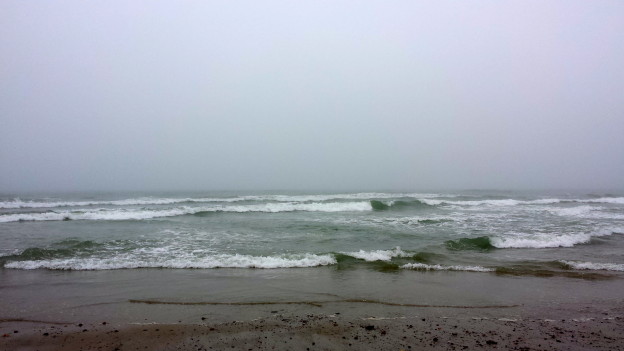I am at the sea for a week of writing. When I take a break to watch the ocean, the waves are barreling in, pressured, low tide reversing itself. White caps, rolling curls. A tempest of sorts.
I leave my striped beach chair and take a walk way down the beach, past all the orange ropes delineating nesting areas for the plovers. We make much more effort for those darling piping plovers than we do for children in the ghettos. How does that happen? More priority given to the environment these days than poverty. It keeps changing, like the tide.
I march off to my right, towards the point, the sea calmer than on my left. After a mile or so I duck under another orange cord and keep going. I edge closer to the water. There are gulls, of course, and they don’t seem bothered. I see one sitting on the wet sand and worry that I might be disturbing its egg laying routine, but when it rises to walk away, there is no evidence of anything left behind. I suppose the ropes differentiate between plover nesting and gulls. I push on.
At one point, though, I hear a wild chattering overhead and spot a plover circling rapidly. It seems agitated. I think it must be upset about a gull wandering nearby or something threatening, when I suddenly notice it turning on its axis, and it’s as though I can see its eyes boring into me. It seems to gather all its determination and makes a beeline, it would probably be called a plover line in this case, for me. It’s just like all those war movies where the plane revs up and flies directly at a target, the drone picking up pitch and volume as it gets closer.
I raise my hands over my head and run. I run fast and panting back to the area with the trucks and families. That plover doesn’t shut up or turn back until I’m long gone.
At another roped area I see a different plover cackling at a gull in its territory. It also must have hatched some eggs. The gull at first walks backward on its skinny triple toed feet. But at some point it gets the message and rises in flight. And doesn’t that plover follow it at triple speed and attack the gull on the chest, midair? Amazing.
Alright then. A mother enraged. The instinct to protect – muscles, vocal cords, speed… all magnified. There is no end to what we can do when infused with adrenalin. Go amygdala… wait – do birds have amygdalas?
I attempt a walk one more time, the day I am leaving the beach and my short writing time. I start off like before, marching forward toward the orange ropes, but as soon as I dart under the very first one, I spot two plovers doing something on the ground nearby. Do they read the little printed signs that state…no entry, birds nesting, trespassing will be punished by the federal government? How do they know where to lay their eggs anyway? But after a minute, sure enough, those two plovers are up in the sky chattering and flying around. Now there are three, four of them… all squawking. I retreat back to the other side of the rope.
Really? They are going to leave me alone on this side? The plover police give it up on this little peopled section of the beach? The rituals are strictly observed, just like when driving and all the people stay in their lane like they’re supposed to. A miracle of obedience.
A writer tells me a story this week. A friend of hers, an African scientist, was scheduled to join a scientific expedition on a Russian ship. He showed up with his passport to board but the officials refused him entry. They were boycotting South Africa because of apartheid. “Well,” he said. “As you can see, I am a black African. It makes no sense to restrict me. I am clearly not a supporter of apartheid.”
The Russians did not budge. Rules are rules.
At this beach, the plovers are shouting at me, “Haven’t you read the sign, you imbecile? This is our turf. Go back to yours.”
So I do.
